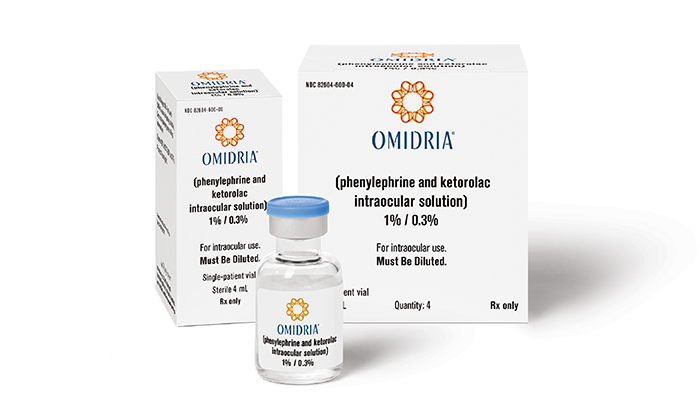
What do you see as the current challenges around the standard of care in cataract surgery medication regimens?
Dr. Kourtney Houser: There’s no consistent standard of care that is universally followed. Many doctors prescribe a drop combination that results in 100s of drops in the eyes over several weeks to a month following a variable tapering schedule. This is complex and challenging for patients.
Dr. John Hovanesian: Another problem of course is compliance. When we burden the patient with topical antibiotic, steroid, or NSAID, that’s four times a day, that's a lot of drops to keep track of. If I tried to take a medication four times a day myself, I would surely miss many doses. But we expect our patients to put in drops that may sting and tell them to be careful not to waste or contaminate any. Just opening a bottle of eye drops can be tough. It’s no wonder we have such poor results when we rigorously measure how patients take their drops.
Could you elaborate on the benefits of dropless regimens to patients – as well as to clinics and surgeons?
Houser: For patients, of course, it takes lot less time. For the clinic and the doctors it means fewer call-backs and less counseling time. If we had the technology where we could deliver a consistent and reliable drop-free regimen, our patient call-backs for drops and prior authorizations would go down significantly.
Hovanesian: Cost is a big burden for patients and a huge problem for staff. But items that are covered as separate payment in the US, such as OMIDRIA, bring additional benefits. There's a little bit of work upfront to verify coverage, but the result is that you take away all the phone calls and post-surgery, post-prescription activity that you may have with other medications. There are a lot of reasons doctors and patients like dropless regimens.
Could you talk a little bit about your experience of using a regimen including OMIDRIA?
Houser: I recently started using OMIDRIA, having not used it regularly before. For me, combining OMIDRIA for a drop-free regimen with, typically, a subconjunctival steroid depot such as triamcinolone acetonide (TA), gives a more sustained release anti-inflammatory delivery after surgery. Starting the regimen during surgery with a non-steroidal action is also helpful for pain control, and also for some of the inflammation afterward.
I’m excited about the new studies in the pipeline which will give us more data regarding combinations of intraoperative and postoperative anti-inflammatory treatments using OMIDRIA for a more reliable drop-free regimen for many patients, such as those with dexterity issues who may have trouble getting drops in. There is also a subset of patients that may be at a higher risk of postoperative inflammation, and such treatment options would be a huge help for them, even if we’re not targeting a completely drop-free regimen.
Hovanesian: The other major reason for using OMIDRIA is that it makes surgery safer. I think of it as a partner in postoperative care, who is there to make tough cases easier – or keep easy cases easy. OMIDRIA is a combination of phenylephrine and ketorolac, which serves to keep the pupil dilated and prevent miosis. There are cases where you start with a well-dilated pupil, and it doesn't always end that way; for a variety of reasons, pupils constrict and that can become quite a challenge in surgery. Every surgeon is familiar with the 5 mm pupil at the beginning of the case that can cause some stress. Mechanical pupil expanders are not always necessary, but that’s only true if the pupil doesn’t constrict further. Steve Silverstein showed in a study that we don’t see constriction, we don’t see billowing of the iris, we don’t see any untoward developments nearly as frequently in eyes that receive OMIDRIA, as opposed to those that receive epinephrine or other drugs to try to keep the pupil dilated (1). Eric Donnenfeld also did a study showing that OMIDRIA reduces the need for pupil-expanding devices and reduces complications in cataract surgery (2).
So, here you have a product that does all those things, is most often free to the surgeon, is most often free to the patient, and is FDA-approved specifically for those indications. Why wouldn't we use it for every patient that we have?
Kourtney, could you talk about your experience with OMIDRIA plus TA?
Houser: Subconjunctival TA is typically my go-to right now when I need to do a drop-free regimen. Subtenon triamcinolone depot works very well also and may last longer, but as there is a risk for intraocular pressure elevation with any delivery, I tend to inject subconjunctivally as I can excise the depot more easily if needed. I often combine this with intracameral moxifloxacin and recently I’ve started combining with OMIDRIA and I find that it works really well for patients.
I do exclude patients with a known steroid response or known glaucoma without a functioning drain of some sort, but I rarely have breakthrough inflammation, which means happier patients, more confidence in the surgery, and the office is happy because patients aren’t coming in for extra visits and calls. It’s pretty simple to do. I think we all have triamcinolone in the operating room and it’s a great adjunct for other technologies like OMIDRIA to give us confidence that after surgery we can control the inflammation.
John, could you outline your recent study, which compared OMIDRIA with a current standard of care?
Hovanesian: We did a recent study where OMIDRIA, combined with a depot steroid, dexamethasone intracanalicular, which is Dextenza,® and intracameral moxifloxacin was compared to a three-drop regimen. We looked at patients’ preference to these regimens, asking, for example, whether we could do one eye with the dropless regimen, while the other eye had the three-drop cocktail. We looked at other parameters like vision, pain, and inflammation. The patients’ preference was overwhelmingly with the eye that had the dropless regimen (we randomized which eye was operated first). As far as pain was concerned, we were quite surprised to see those patients with dropless surgery reporting significantly less pain, both before and after surgery. The dropless regimen was similar in terms of inflammation and visual acuity recovery (3).
What do these findings mean in practice?
Hovanesian: While OMIDRIA has wonderful properties to do what it’s indicated for, which includes reducing pain after surgery, for some of our patients we want to have the assurance of an ongoing dose of non-steroidal after surgery. So, what I’ve evolved in my own practice is a single-drop regimen, which in our case is bromfenac (PROLENSA, a Bausch and Lomb product), that patients use once a day for about a month. If they’re diabetic patients, patients with an epiretinal membrane, or those who have a compromised blood retinal barrier, we may continue the treatment longer, to six or eight weeks or more. But the standard is one drop, once a day for one month.
Eric Donnenfeld is working on a control study right now looking at COX-1 and COX-2 receptor suppression with OMIDRIA. If this data shows the level of ketorolac that stays in the aqueous and vitreous post-cataract surgery, would that have many benefits?
Hovanesian: The vitreous is a natural depot for drugs, so it’s likely the new Donnenfeld study will show therapeutic drug levels in the eye far past the 10 hours that have been proven so far. So, we've probably got a long runway with this product. As far as influencing practice goes, it's going to take that data demonstrating a difference.
Why do you think dropless regimens haven’t been adopted more in the past?
Houser: We do not have great data to support a consistently reliable drop-free regimen, which is a deterrent for many surgeons. Also, when rebound inflammation occurs with a drop-free regimen, we see an increase in patients calling back with complaints of rebound inflammation, which unfortunately drives many of us away from the whole class of treatment. I think having good data to support a combination of technology will get people back on board.

Drs Hovanesian and Houser may be paid consultants of Rayner.
US-OM-2300043 11/23
References
- SM Silverstein et al, “Effect of phenylephrine 1.0%-ketorolac 0.3% injection on tamsulosin-associated intraoperative floppy-iris syndrome,” J Cataract Refract Surg., 44, 1103 (2018). Erratum in: J Cataract Refract Surg., 44, 1537 (2018). PMID: 30078537.
- ED Donnenfeld et al, “Intracameral ketorolac and phenylephrine effect on intraoperative pupil diameter and postoperative pain in cataract surgery,” J Cataract Refract Surg., 43, 597 (2017). PMID: 28602319.
- ED Donnenfeld et al., "A randomized, prospective, observer-masked study comparing dropless treatment regimen using intracanalicular dexamethasone insert, intracameral ketorolac, and intracameral moxifloxacin versus conventional topical therapy to control postoperative pain and inflammation in cataract surgery," Clin Ophthalmol., 17, 2349 (2023)
